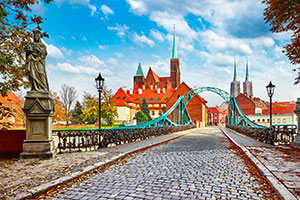The historic cultural hubs and colorful folklore of Bohemia take center stage on this 15-day encounter with Germany, Poland, Hungary, Austria and the Czech Republic. You’ll witness the triumph of the human spirit, explore the medieval history of enchanting towns, and uncover myths and legends of this multicultural crossroads. Discover the heart of Europe-your way.
Krakow
Krakow
Top attraction and the premier tourist destination in Poland, Krakow (dated English spelling ‘Cracow’) is a vibrant city, proud of its long and glorious history, rich heritage, and architectural beauties. For centuries Krakow was the capital of the Polish kingdom. Today it remains the southern Poland’s metropolis and the seat of the Malopolska provincial government. Important as a crucial center of business, culture, and education, Krakow is also famous for its restaurants and clubs. Krakow is Poland’s capital of culture and was named a European City of Culture in 2000. The city boasts the best museums in the country and some best theaters. It counts two Nobel Prize winners in literature among its residents. It is also home to one of the world’s oldest and most distinguished universities.
|
Destination Guide
|
Prague
Prague
Amid Prague's cobblestone streets and gold-tip spires, galleries, cafes, and clubs teem with young Czechs and "expatriates." New shops and restaurants have opened, expanding the city's culinary reach beyond the traditional roast pork and dumplings. The arts and theater also thrive in Prague. Young playwrights regularly stage their works, weekly poetry readings are standing room only, and classical music maintains famous standards, while the clubs are jammed. The arts - nonverbal theater, "installation" art, world music - are as trendy in Prague as in any European capital but possess distinctive Czech flavor. All of this is set against a stunning backdrop of towering churches and centuries-old bridges and alleyways. Prague achieved much of its glory in the 14th century, during the long reign of Charles IV, king of Bohemia and Moravia and Holy Roman Emperor. Charles established a university in the city and laid out the New Town, charting Prague's growth. Prague Castle is the most popular sight and is the largest ancient castle in the world with three courtyards.
|
Destination Guide
|
Vienna
Vienna
Vienna is dominated by imperial castles and places: Schonbrunn, the magnificent summer residence, the Imperial Coach Collection, the Palm House, the Butterfly House, Belvedere Palace, magnificent state rooms in Hofburg, and the imperial crown in the Treasury. Stop by Ringstraße - the showplace of the monarchy built where Emperor Franz Joseph ordered the demolition of city walls. Important buildings include the State Opera, the Museums of Fine Arts and Natural History, Parliament, City Hall and Vienna University. The world capital of music. A long line of great composers Johann Strauss, Haydn and Mozart, Beethoven and Schubert, Mahler and Schonberg all worked here. A city with splendid concert halls, such as the Golden Hall, from which the Philharmonic's New Year's Day concert is broadcast annually. International stars love to appear here in the State Opera, Volksoper, Konzerthaus, and at festivals like the Vienna Festival, the Klangbogen concerts during the Musical Summer, the Jazz Festval and the Haydn, Mozart and Schubert festivals.
|
Destination Guide
|
Budapest
Budapest
Caught between eastern and western Europe, Budapest has a character uniquely its own. It's also the last cheap, civilised city in Europe. Budapest can seem like one big sight, with each phase in its history, from the Ottoman period until the Communist days and from renaissance to revolution, leaving its mark on the city. For the tourist, a trip to Hungary's capital is dominated by the majestic sights of Buda. In the summer, there are open-air festivals at Szeged, Diosgyor Castle in Miskolc, Gyor and Pecs. Visit the former Royal Palace complex, the Matyas templom and the Belvaros. Margaret Island is a giant recreational park and feels pleasantly separated from the city bustle. Hungarian National Gallery houses Hungarian art since the birth of the nation. Although Esztergom is Hungary's most sacred city, home of the Archbishop and the nation's biggest church, it has a real-life edge. The first-time visitor to Szeged is invariably struck by its space and grandeur. One's immediate impressions of Hungary's third largest provincial city are of greenery and plazas, of broad.
|
Destination Guide
|
Warsaw
Warsaw
Warsaw is not the cold and dead city it used to be under communism rule. Today with bustling Polish economy and freedom from communist rule - the city has undergone a huge transformation process. Many old communist buildings gave way to modern sky scrapers, dilapidating old town was restored, entertainment and services transformed to match that of other western capitals. Crime rate is lower than that of big cities in the United States. Today Warsaw boasts GDP per capita more than 75% of European Union average.
|
Destination Guide
|
Berlin
Berlin
Berlin is without doubt the most fascinating city in Germany. Covering around 341 square miles Berlin is a unique landscape. With its numerous parks, lakes and wooded areas it is sometimes easy to forget that Berlin is the capital of Germany. The troubled history of this celebrated capital has for many years attracted tourists from around the world. It is estimated around 80% of Berlin was destroyed during the Second World War; landmarks like the Kaiser Wilhelm Memorial Church stand as a lasting reminder of the mass destruction this city once endured. Perhaps one of Berlin's most famous landmarks is the Berlin Wall, the 'iron curtain' that divided this great city into two halves between 1961 and 1989. The East was governed by communism while the West was allowed to flourish under a democratic capitalist government. Even now, over a decade after the fall of the Berlin Wall, the differences between the former East and West are still very apparent. Berlin has an undeniable air of mystery that has always been and always will be a major draw for tourists from around the world.
|
Destination Guide
|
Frankfurt
Frankfurt
Frankfurt is the city of the International Book Fair, the National Library - a city encompassing a variety of publishing houses, libraries and bookshops. In its museums, exhibition halls, and art galleries, Frankfurt displays its distinct style of contemporary and historical art and culture. Frankfurt's highrises form part of the city's identity. The skyline is unique, thanks to its extraordinary architectural blend of tradition and modernity. Europe's largest skyscraper is also situated here, the Commerzbank building. Frankfurt is home to one of the world's finest ballet ensembles. Frankfurt is a metropolis for techno and dance music, which lends the city a reputation of musical magnetism. The city's numerous theaters and theater groups, the opera, and the concert house Alte Oper offer Frankfurt's stage aficionados and lovers of fine arts a comprehensive and diverse program.
|
Destination Guide
|






